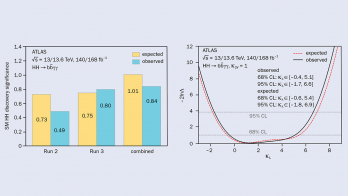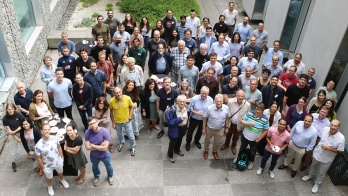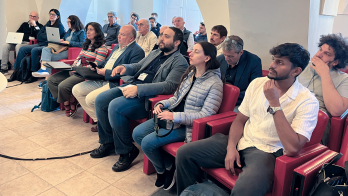Precise measurements of final states containing multiple electroweak bosons (W, Z or γ) offer a powerful probe of the gauge structure of the Standard Model (SM), and are therefore a promising avenue to search for new physics. Using proton–proton collision data from the LHC collected at centre-of-mass energies of 7, 8 and 13 TeV, the ATLAS collaboration has recently measured the cross-section for boson-pair final states with unprecedented precision, challenging calculations from quantum chromodynamics (QCD).

For example, the uncertainty on the total production cross-section measurement of the WZ final state at 7 TeV is approximately 10%, which is large enough to cover the differences between the next-leading-order (NLO) and next-to-next-to-leading-order (NNLO) QCD predictions. At 8 and 13 TeV, the uncertainties on the ATLAS measurement reveal a tension with the NLO prediction, although this has been mitigated by recent NNLO QCD calculations.
The large size of the 8 TeV data set allowed ATLAS, for the first time, to become sensitive to tri-boson production and also to boson pairs produced through vector-boson scattering. The production cross-section of such processes in the fiducial volume where the measurement is performed is of the order of 1 fb or less, which is very difficult to measure. ATLAS performed significant cross-section measurements of the Zγγ, Wγγ, and W±W±+2j final states, while limits were set on the production cross-section of the WWW and WZ+2j final states.
These measurements probe the gauge-boson self-couplings, which are sensitive to contributions from new physics – especially at high energies. To parameterise possible anomalous gauge couplings, an effective-field-theory (EFT) approach was used. The ATLAS collaboration has searched for deviations in the coupling of three gauge bosons in the WZ final state using data collected at collision energies of 8 TeV and 13 TeV. By including the 13 TeV data, the previous sensitivity on the EFT coefficients (CWWW/Λ2, CW/Λ2, and CB/Λ2) has improved by 40%. No evidence for new physics has been found and new limits have been derived.
The large data set from LHC Run 2 will provide sensitivity to rare processes that have not been observed so far, and the expected high accuracy on multi-boson cross-sections will allow higher-order QCD and electroweak corrections to be probed.








